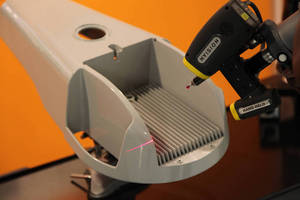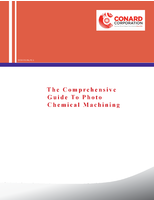NVision's HandHeld Scanner Helps Ensure Top Quality Production of Aluminum Die Castings for LED Lamps
Share:

Coppell, TX – Lighting Science® uses the HandHeld laser scanner from NVision to ensure the dimensional integrity of the extremely complicated castings it purchases and uses in its roadway light emitting diode (LED) fixtures. In the past, it was difficult to inspect the castings because their geometry was too complex for gauges and blocks and they would have taken a long time to program and inspect on a coordinate measuring machine (CMM). “With the NVision HandHeld laser scanner we can, in about two hours, obtain the complete 3D geometry of a casting and compare it to the design intent to determine not only if the part meets the design intent but also whether it is trending in the correct direction,” said Richard Williams, Manager, Product Quality Assurance for Lighting Science.
Lighting Science designs, develops, manufactures and markets LED lighting solutions that are environmentally friendly and more energy efficient than traditional lighting products. The company uses the HandHeld scanner to evaluate many of its LED solid state lighting components. The company’s new RoadMaster™ street light is one example of the component parts evaluated with the scanner. The RoadMaster provides a reduction in energy costs during its extended operating life, helping municipalities and communities avoid soaring energy and maintenance costs associated with traditional high pressure sodium (HPS) street lights. The RoadMaster pays for itself by avoiding just one HPS lamp replacement, let alone the 4-6 traditional street light changes it is expected to avoid over its rated life.
The Roadmaster fixtures are built around large 2 feet long by 1 foot wide aluminum die castings. The aluminum has a tendency to scavenge the steel dies so over time the features of the castings gradually move out of tolerance. The steel dies used to make the castings typically last from 25,000 to 50,000 shots. It’s critical to inspect a sample of parts received from suppliers to ensure that they are within specifications. But the geometry of the parts is so complex that it would take several days to inspect them with gauges and blocks. As for using a CMM, it would take an estimated week to write a program to inspect each of the many variants of these parts and about 4 hours to inspect each part because of the large number of points that need to be touched one at a time to validate the 3D geometry.
“We heard about the NVision HandHeld scanners’ ability to quickly capture the complete geometry of a complex part and thought it would be perfect for this application,” Williams said. “It takes the operator about one hour to scan the casting and generate a point cloud that completely defines its geometry. Then it takes another hour or so to convert the point cloud to a surface model and compare it to the design intent. Then we use NVision software to compare the as-built part to the design intent. The software highlights in green those areas of the part that are well within tolerance, in yellow the areas that are on the high side of tolerance, and in red any areas that are out of tolerance. This information provides an early warning when we are moving towards the edge of the spec so we can make corrections and avoid the need for scrapping parts.”
The HandHeld scanner is a revolutionary portable scanning device which is capable of capturing 3D geometry. The scanner is attached to a mechanical arm that moves about the object, freeing the user to capture data rapidly and with a high degree of resolution. An optional tripod provides complete portability in the field. Intuitive software allows full model editing, polygon reduction, and data output to all standard 3D packages. NVision software allows you to compare the scan data of your parts against your CAD model. Comprehensive inspection reports including color deviation plots, GDT, 2D dimensions, flush and gap, animations or application-specific dimensions such as turbine blade measurements are available as output.
For more information, contact:
NVision, Inc.
440 Wrangler Dr
Suite 200
Coppell, TX 75019
Ph: 972.393.8000
Fax: 972.393.8002
E-mail: sales@nvision3d.comÂ
Visit NVision's Web site at http://www.nvision3d.com/
About NVision
NVision, Inc. (www.nvision3d.com) was established in 1990 with one goal in mind: to provide customers with the highest accuracy non-contact optical measurement systems and services for Reverse Engineering and Inspection. Focusing our expertise on the aerospace, power generation, and oil/gas industries, NVision provides both contract scanning services and systems sales to companies throughout North America. Our elite team of engineers provides customers with an unmatchable level of experience and is able to advise and assist with the most difficult engineering challenges.
NVision’s clients include industry leaders such as Alstom, Boeing, GE, Lockheed, Lear, NASA, Porsche, Raytheon, Siemens, Toyota, and every branch of the U.S. military.
About Lighting Science
Lighting Science Group Corporation (OTCQB: LSCG) is a global leader in the design and development of lighting solutions that are environmentally friendlier and more energy efficient than traditional lighting products. Lighting Science is on a mission to improve the planet and its people with award-winning, innovative LED lamps and lighting fixtures. Conceived, created and built by some of the best people in the lighting field, these products help save energy and reduce the carbon footprint without sacrificing light quality. Find out more at: http://www.lsgc.com




